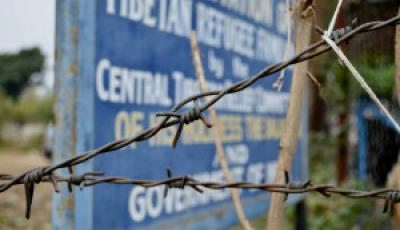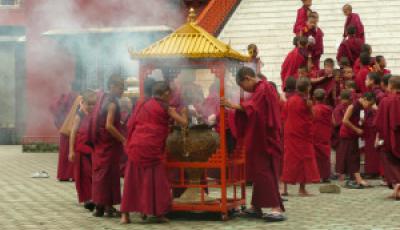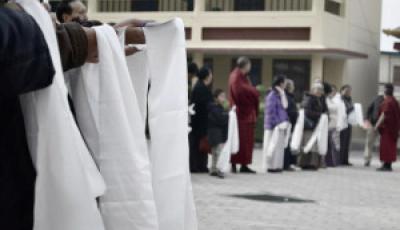Tibetan Women and Nuns: What’s Missing in Our Discussion on Borders and Gender?
Posted:
Time to read:
Guest post by Bodean Hedwards, PhD student at Monash University, Australia and member of the Border Crossing Observatory. This post is part of the joint blog series on ‘Gender and Migration’ co-hosted by Border Criminologies and COMPAS. Posts in this series will be published on both blogs every Friday until the end of June.

The Borders Inside Tibet

One of the biggest assaults on Tibet during the Cultural Revolution was the dissolution of gender boundaries through the integration of the monastic and lay communities, as described by Charlene Makley. In pre-1950s Tibet, traditional Buddhist society structures deemed the Buddhist nuns as a third gender, which determined their place in the monastic community and changed what would have been the traditional social passage, which largely ended in marriage. Following the Communist occupation, the clear gender structures within the Tibetan community became blurred. The social expectations of women shifted, leading to what has been referred to as ‘communist androgyny.’ Women were moved from traditional household lifestyles into the political sphere, despite being historically reserved for men and monks. Tibetan nuns were removed from the nunneries, returned home and forced to marry. In prisons, nuns became what Robert Barnett described as a ‘site of performance,’ whereby Chinese officials played out their authority by forbidding the nuns to cut their hair―a rule not applied to other women in the prison, or to women anywhere else in the world. The gender confusion was carried into the post-Moaist Tibet, where women in the public sphere and nuns became a ‘site of resistance’ in the revival of traditional Tibetan culture and social structures.

The Border Around Tibet
Conversations I’ve had with Tibetan refugees in India reveal that as with other refugee flows in the global south, human rights is the predominant motive. However, we know very little about border realities in this region or narratives of persecution, particularly among women and nuns in Tibet. Determining how gender interacts with border crossings is complex, as there are cultural, political and religious factors that result in gender playing out in other ways. I explore how gender is performed―or not performed―in the way individual women and nuns told their border crossing stories.
It could be argued that the manipulation of the gender structures in Tibet has resulted in women shifting their individual narratives to a non-gendered, ‘Tibetan’ narrative that is historically, culturally and politically aligned with the goals of the Tibetan government in exile. It became evident after hearing the stories of Tibetan women, that gender manifests as secondary to being Tibetan. Robert Barnett’s examination of women and politics in contemporary Tibet described this situation:
…she stands accused of fabricating her claim to have lived in Tibet, or even to be Tibetan; if her story is found to be false, she faced deportation. Apart from her memories and her papers it is only her body that now remains to represent what is Tibetan about her, and it is not believed. She resists the accusation of deception by what we might call ‘performing her nation’, in this case by presenting a narrative that establishes her as part of the extended Tibetan body politic and identifies herself within a history of nationality oppression and resistance.
Instead of presenting herself as a woman subjected to political persecution, she chose to portray herself first and foremost as Tibetan. Similarly, where respondents discussed traumatic experiences with me, they switched between their individual experiences, to the broader experience of Tibetans. The majority of female respondents indicated they were subjected to some form of human rights abuse, often involving severe reporting measures that restricted their freedom of movement or intrusive surveillance of their religious and political activities. While sharing these stories, the women switched between their own personal experience and those of all Tibetans, often adopting historical narratives in describing their own experience. The interchange between the individual and collective narrative became a routine feature of these stories. However, when participants detailed their experience of more severe abuses―such as being beaten or tortured in prison―the narrative remained individualised, yet void of detail.

The shift from the individual through to the collective presents many challenges in interpreting the individual experiences of human rights abuses. When gender is not examined as a driver of migration, or a culturally specific influence on an individual’s story, criminology is missing a unique interaction with the physical and non-physical dimensions of borders. When human rights abuses are identified as the key driver for migration, understanding the ways individuals experience that driver are difficult unless direct personal experiences are elicited. Although gender is explored here in a way that’s not necessarily a border crossing experience in itself, it sets a significant methodological and conceptual challenge as gender, like the experience of human rights abuses, is not always a personalised characteristic for individual stories.
Any thoughts about this post? Get in touch with us! Send us an email, or post a comment here or on Facebook. You can also tweet us.
__________
How to cite this blog post (Harvard style):
Hedwards, B. (2015) Tibetan Women and Nuns: What’s Missing in Our Discussion on Borders and Gender? Available at: http://bordercriminologies.law.ox.ac.uk/tibetan-women-and-nuns-borders/ (Accessed [date]).
Share:








